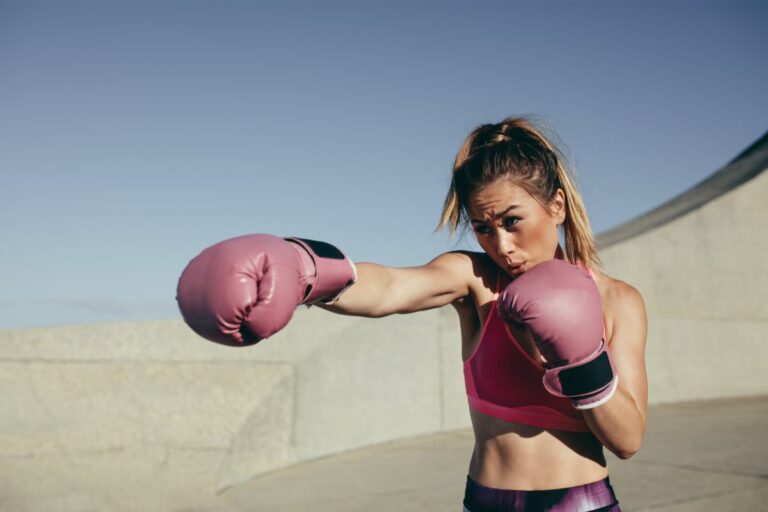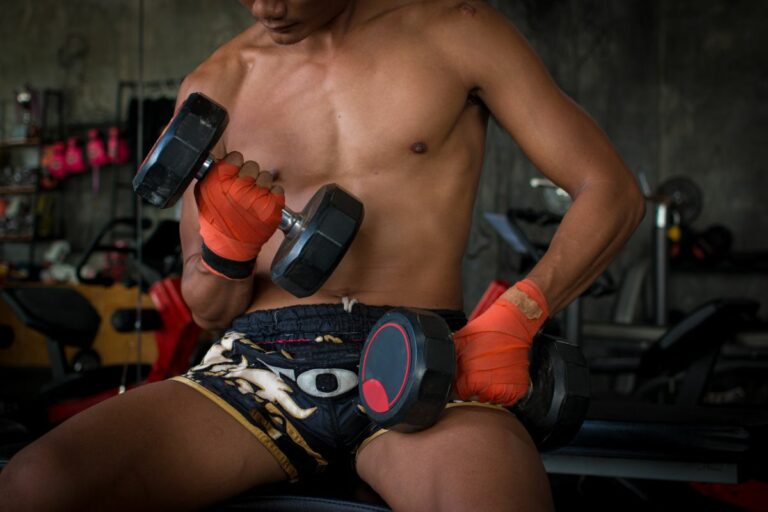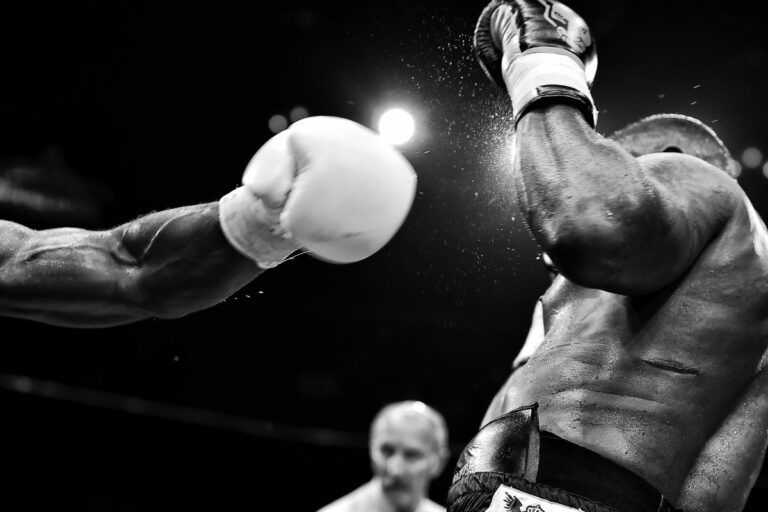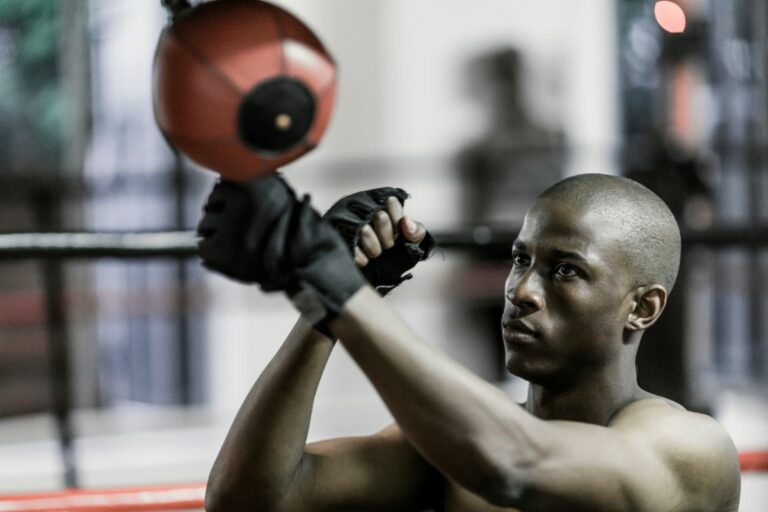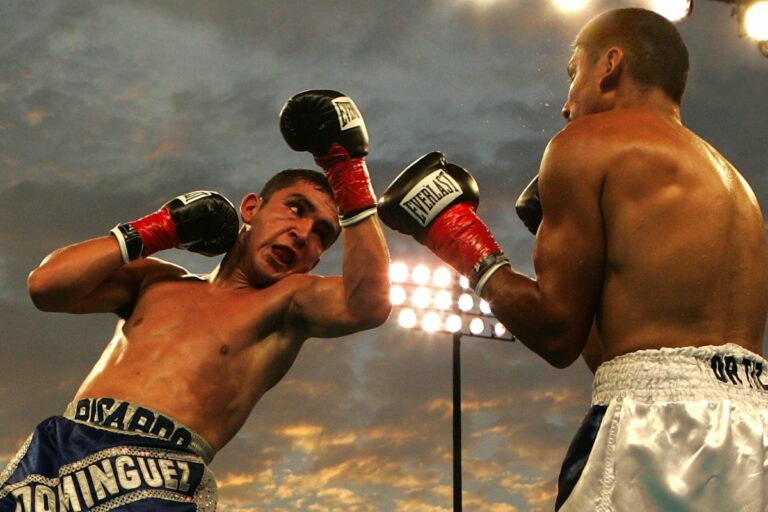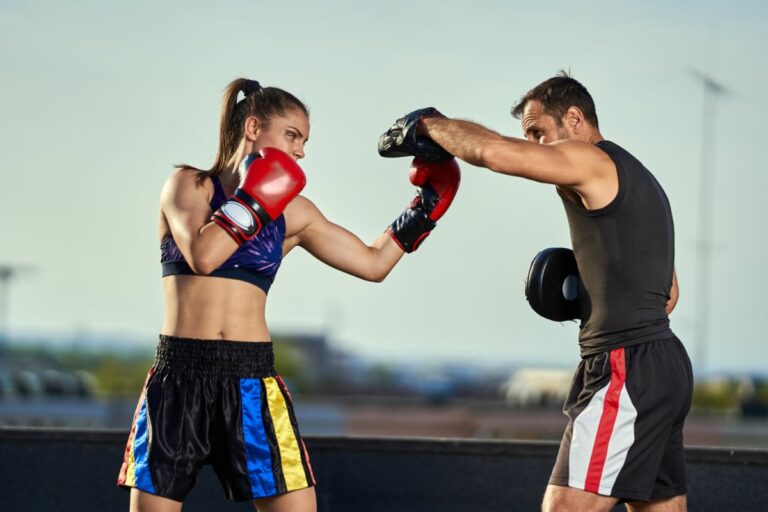What Muscles Are Used When Punching? (Explained!)
Have you ever wondered what muscles are used when punching?
Today, this article will take a look at all the muscles used during this movement pattern and some tips on how you can improve it.
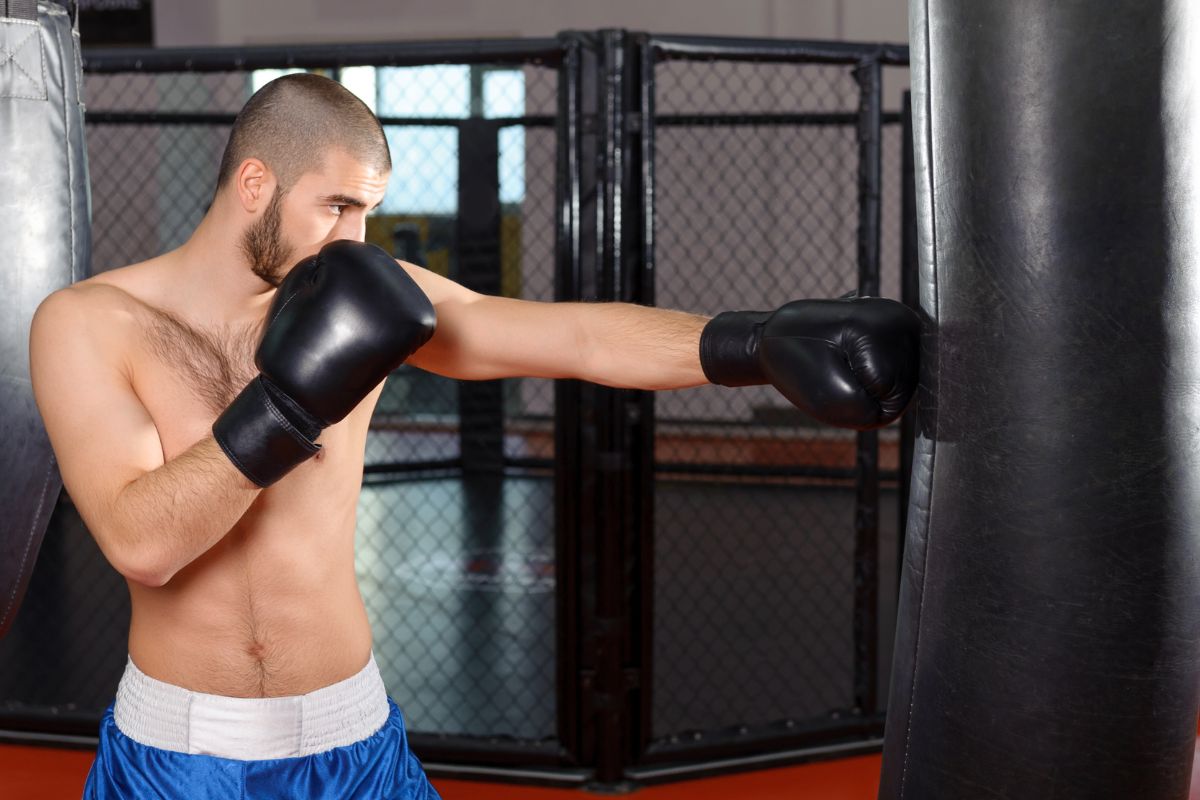
Many people in our audience move past the beginning stages of boxing. And once they make it past this stage, we start to see the lights in their eyes as they begin to appreciate the sweet science of boxing truly.
As you reach that intermediate level, there’s no doubt you’ll want to be as efficient with your striking capabilities as humanly possible.
In order to do this, you’ll need to understand the physics of boxing, how a soft punch will stop you from achieving in the ring, the anatomy behind the perfect punch, and what you can do to increase the power.
What Muscles Are Used When Punching?
You may not be surprised to hear that the body generates a lot of movement in a punch. O, and with that, a lot of muscles are activated.
Has the body twists to generate a decent amount of torque, the arm extends and a punch is delivered.
Within this punch, you will use your calves, glutes, quadriceps, hamstrings, and hips to carry this out. And that’s just the lower body.
In terms of your upper body, you will use your shoulders, back, biceps, triceps, and the serratus anterior, which is also commonly known as the boxer’s muscle; this will allow the boxer to extend the arm and create a force to generate a punch.
Many beginner boxers, but also intermediate-level boxers, are surprised to hear that a lot of energy is used in the lower body.
This is why we always recommend our boxers not forgo working their lower body, as they will lose a lot of power in their punches.
Losing a big proportion of this kinetic chain can hamper a boxer’s performance.
If you are using your legs, glutes, your abdominal and core muscles, and the obvious upper body muscles, any weak link in this chain will hamper your performance, meaning that those boxers who skip leg day will suffer the consequences.
We can also go more in-depth into the mechanics behind specific movement patterns and how the muscle will help you create a powerful punch.
Muscles And How They Work During A Punch
If we start with the glutes, Which are the largest muscles in our bodies, your glutes will tighten which will allow your hips to extend forward.
This extension of the hips helps to create a sturdy core and stops you from going limp in the middle.
Sticking with the lower body, we moved to the thigh and the quadriceps. Depending on the type of punch that you carry out, Your quadriceps will either tighten or loosen.
Moving upwards towards the abdominal muscles, specifically, the obliques helps to control rotation in the torso, and as you generate energy from your feet through your thighs up through the glutes and into the midsection of your body, this energy continues upwards and towards your punching hands.
The serratus anterior, which is located by your rib cage, will help to extend the arm away from the shoulder and the rib cage.
The shoulder muscles; AKA the deltoids help to raise your arm so that you can get into a punching movement pattern.
The triceps provide extension, whilst the finger extensors will tighten in your forearm, which helps to stabilize the wrist and helps to prevent injury down the line. You do not want to punch with a limp wrist.
Finally, your finger flexors tighten which closes the Fist and provides all the stability you need for when you’re pissed impact against your opponent.
When you consider all the muscles in play, and how much your body requires so many different movement patterns, it’s surprising that many of the boxers we see never reach their full potential.
Failing to get one of these movements correct, the entire punch can become compromised, which is why we pride our fighters on learning outside of the ring as well.
How Important Is Technique When Punching?
Although we strongly recommend our fighters learn the ropes of a punch from an anatomical and biomechanical perspective; it’s also true that a fighter’s punching power is all about technique.
This means that you can’t simply rely on theory alone, so being book smart is not enough.
No wonder so much emphasis is put on footwork, it is from generating energy that moves through the body, originating from the feet.
As the foot slightly twists and as the body adjusts It Moves the energy up through the body up to your shoulders, down the arm, and out of your fist.
To see this in action, watch some of the greats and how their body moves during a punch. They are not static, you’ll easily notice how much their body twists.
Almost always you’ll see energy being generated from the ground up. The upper leg and hips will twist, allowing for our kinetic energy to travel upwards.
That’s why we rarely see boxers who only punch from the hips, or punch from the upper body. Less kinetic energy equals less force generated.
Just as important is the center of the body.
As energy drives up through the feet it will reach the abdomen and the torso. with the upper body and shoulder move, this creates the final twisting motion as you direct the energy toward the opponent.
Let’s not forget that the shoulders are one of the most complicated groups of muscles in the body.
The shoulder moves away from the center of your body, specifically the rib cage, and as the arm extends and the target is struck, all the energy will transfer into power.
If a fighter is looking for the perfect punch, they will need to rotate their wrist and essentially turn it over. This will deliver A punch with maximum impact, giving you a better chance of causing more damage or scoring for yourself.
Therefore it is in your best interest to focus on technique as well as the science behind the perfect punch. Though, focusing on technique should be your first port of call.
Your best bet is to have a look at some videos of professional fighters and check out all of our resources to help guide you towards improved performance.
These resources should give you ample theory on positioning, speed, footwork, and of course; technique.
Everything that has been explained above is related to the standard boxing punch, i.e. the standard cross. whilst there is a wide range of different punches and techniques to this punch, I will only cover the basics in this article so as not to overcomplicate things.
How To Increase The Power Of The Punching Muscles
So we’ve worked out what is required to land a devastating blow, but we know what you are probably thinking: how on Earth do I increase the power of my working muscles?
Because punching uses a wide variety of muscles throughout the body, it’s prudent to tackle each muscle individually to help bolster them.
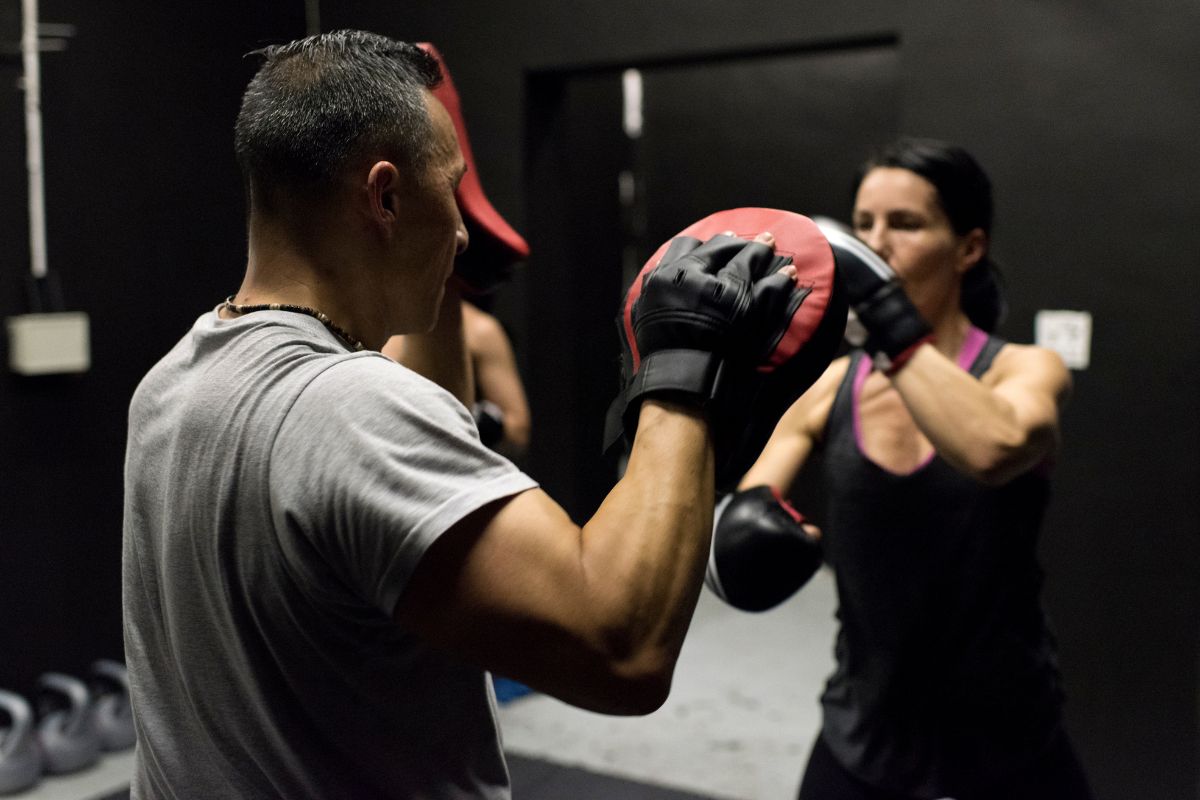
We’ve mentioned this before, but this means you can no longer skip leg day if you’ve not been given the love they deserve.
Having the ability to generate power and making those muscles a lot stronger is easy when you follow these steps:
Improve Technique
Actually practicing how to punch is so vital we are going to bring it up again.
You wouldn’t teach someone to play Tennis by getting them to read a variety of books; you would put a racket in their hands and get them onto a tennis court.
Practicing techniques will improve your form, allowing you to have more efficiency in your power transfer. This dedicated practice will naturally strengthen the muscles that are used when punching.
We sometimes hear of boxers saying their abs are on fire after a session when they haven’t even done any dedicated abdominal training.
Even if you aren’t meaning to use the muscles, they will still get a workout as they are required in the movement pattern.
Over time, you might notice changes to your body, and we also see many boxers increase the circumference of their arms and round out their shoulders simply from practicing good technique with their punching.
Putting these muscles under stress is a sure-fire way to build them up.
Increase Weight When Resistance Training
We hope that you have some form of the resistance training program in your weekly workout schedule. Not only to help build muscle mass but also to iron out any muscle imbalances and prevent injury.
You might notice that with your own personal punching technique, some muscles develop faster than others.
This is a natural occurrence when learning to box and to correct any potential imbalances you need to have some form of weightlifting in your program.
Everybody is built differently and has different generics that will determine what will develop quickly, and what is lagging behind.
Training Modalities
Overall strength improvements have so much to carry over to your boxing technique, and the pursuit of these attributes cannot be overstated.
But a focus on mobility, reaction speed, Andover, or conditioning should also be training factors to consider.
Solely focusing on one area of fitness is a mistake from a boxing training point of view.
For example, if you only focus on the weight Room you will never be able to build up your speed and endurance, and if you only focus on technique, you only get so far with your punching power.
We see this a lot with Fighters. They are often skilled in one area and put a lot of Focus into that field but forgo other areas.
Stress your muscle fibers in a wide variety of capacities. This means training strength days where you go all-out for low reps, but also factor in high endurance days.
As boxing requires you to be competent in more than one field, both the slow-twitch fiber and fast-twitch fibers must be looked at.
Both of these muscle fibers are worked at different levels depending on the intensity, and fast-twitch muscle fibers are important for explosive movements, slow-twitch muscle fibers are also important so that you can go long into a fight that lasts more than 5 rounds.
To maximize your potential make sure that you have a well-balanced program.
With the above tips in mind, here are a few exercises that you can incorporate to improve your strength and muscle fibers when looking to increase your punching power.
Muscles To Train For Punching Power
First, let’s take a look at the muscles that you want to target for punching power.
To maximize your punching endurance, but also power, you should focus on building up your latissimus dorsi, or lats, which is the large muscle found on the back of your body that goes all the way up from the bicep, down towards your lower back.
We also already mentioned the serratus anterior, a key muscle worked in a punching movement, which is located on the front of the body near the ribs.
But one lesser-known muscle that is the literal reverse is the serratus posterior which is located on the back of the shoulder blades near the neck.
One thing to note is that the serratus anterior can become overworked in comparison to some of the other muscle groups. Bear this in mind if you don’t go on to add lots of serratus anterior-based exercises. You may not even need them, to begin with.
Let’s also not forget to show some love for the lower body. Incorporate glute work, quad, and hip work, as well as balance everything out with some hamstring work.
Best Exercises For Increasing Your Punching Power
Here are a couple of exercises that we recommend most of our fighters incorporate into their workout routine:
Inverted Row
One of the foundational exercises that every program should have for improving punching power is some form of horizontal row.
There are many ways to achieve a horizontal row, which include dumbbell rows, bent-over rows, or even cable rows.
We recommend the inverted row as one of the best exercises to strengthen your overall back, in particular the latissimus dorsi.
Bodyweight exercises are typically low impact, don’t cost much to do, and can be carried out in most situations so you may not even need to purchase a gym membership.
This exercise helps to build stamina, muscle, and body control in many of your posterior muscles. Having a big back is indeed going to help you translate that big punching power.
Along with this, It will help you twist and extend your punching reach meaning you generate more force when striking an opponent.
How To Do An Inverted Row
- Find a horizontal bar, like a barbell or low-hanging branch, even a flat surface like a table can work here.
- Come underneath the horizontal vast and position your feet a body distance away from the bar, so that your chest is directly under the bar and your feet are sprawled away from it. You should be in a position where it looks like you’re about to do a bench press.
- Grab the bar with your hands and lift your glutes off the ground. In an ideal world, you should be able to grab the bar whilst lying on the floor with your arms completely locked in a fully extended position.
- From here, pull yourself up towards the bar and try to touch the bar with your chest, whilst at the same time making sure to squeeze your shoulder blades together. Doing this will engage all of the correct muscles needed for the inverted row.
- Lower yourself in a controlled fashion, making sure to not just fall back down to the ground and to control the eccentric portion of the lift.
If you have never done this exercise before you may struggle to even do more than five reps.
Therefore don’t be surprised if you start this exercise only by being able to do 2 sets of 5 reps. The good news is that it becomes easier over time, and you’ll be able to get closer to 8 to 12 reps.
If you want to regress the exercise because you’re finding this exercise too difficult, you can make it easier with the position of the angle of the bar.
The higher the position of the horizontal bar the more angled your position will be and the role will become much easier.
To make the exercise harder, you can either add in more reps and sets, or even add a weighted backpack so you increase your total body weight being lifted, or simply lower the bar so that it is closer to the ground.
Push-Ups
Although it’s more common for this muscle group to be developed than other muscle groups such as the latissimus dorsi, we’ll also cover the serratus anterior, which extends the shoulder away from the body.
This muscle, also commonly known as the boxer’s muscle, is the muscle inside your shoulder blade that connects your pec to your rib cage.
This has been shown to improve a fighter’s reach so that you can land a punch a couple of inches over your starting reach.
How To Do A Push-Up
The starting position of the push-up is a lot similar to the inverted, but obviously in reverse:
- Start by placing your body into a plank-based position by extending your feet and straightening your arms. Ensure that your body is in a straight line and that your hips do not sink too low or rise too high. Drawing a straight line from your feet to your head is ideal.
- Begin to lower your chest towards the ground in a slow controlled manner. Do not dive bomb to the ground, making sure to keep things as tight as possible.
- Whilst lowering to the ground, make sure your elbows track at around a 45-degree angle and avoid having your elbows flared out at 90 degrees. This will help to avoid a shoulder or elbow impingement from occurring. You’ll also be stronger when pushing from an angled elbow position.
- Touch the floor with your forehead or your chest, and pause here for 1-2 seconds.
- Begin to rise off the ground and explode upwards, making sure to keep your body in a straight line.
The push-up is an incredible exercise, not only for its accessibility but for its health properties as well. It’s one of the best exercises for overall shoulder health and can be done anywhere.
If you find push-ups too tough, then to begin you can either do angled push-ups by placing your hands on a raised surface, i.e. a box or window ledge and then pushing down towards the ground.
Better yet, you can perform knee push-ups by simply dropping your knees to the ground to reduce the weight you are pushing.
To make this exercise more difficult, you can add weight to your body by adding a weighted backpack or bringing the hands closer to the midline of the body, i.e. diamond push-ups.
Please bear in mind that the closer your arms are to your body, the more you will work your tricep muscles.
Squats
Squats will build our legs and work most of the muscles in your lower body, as well as your abdominal muscles and core.
It’s criminal to see how underrated leg muscles are for boxers, as they generate the most power for the perfect punch. Go and look at boxers like Manny Pacquiao and Mike Tyson and see how big their leg muscles are in their boxing career. Spoiler alert: they are huge!
To complete a squat:
- Stand with your feet around hip-width apart, either pointing the toes slightly out or straight in front of you. Your foot position will ultimately be determined by your mobility and morphology and how your hips sit, as well as your femur length, so trial and error to find which stance is most comfortable for you is required.
- Sink your glutes in between your legs and bend at the knees at the same time, making sure your knees track over your feet the entire time. Bring yourself down so that your knee is roughly in line with your hips, or slightly below.
- Power back up from this position, making sure to keep your knees over your toes and not sticking your butt out too much.
Squats can be made easier or more difficult in several ways. For example, you can simply add weight to the barbell and do back squats, or you could place a box behind you to help you get into the bottom position with relative ease.
Frequently Asked Questions
Can You Build Muscle Using A Punching Bag?
Yes, using a punching workout can help you in your goal to build muscle. Expect to find gains in your chest muscles, biceps, shoulders, and even core muscles.
Although direct muscle work via resistance training and bodyweight exercises will be your best bet for building muscle, a punching bag is useful for using specificity in your training.
Going back to our tennis metaphor; you wouldn’t want to teach a tennis player how to shoot hoops, you would want them to practice serves and returns in a tennis scenario.
With that said, bag work can help to build lots and endurance and you can increase your tolerance to punch repetitively in a boxing scenario, i.e. 2-3 minute rounds.
One of the by-products of all this heavy bag work is going to be energy expenditure.
This means that you are going to lose body fat as a result of the work you’re doing, which translates to a more defined body because there is less fat covering the muscles.
We’re not going to go into your argument about body fat percentages and boxing performance today, but understand that if you are doing lots of intense training for your boxing you will naturally have a low body fat percentage.
Final Thoughts
There is more to the perfect punch than simply bringing your fist to a surface as quickly as possible, and now you know that the entire body is involved in generating power.
We recommend that you incorporate some of this advice into your training and focus on not only technique, but build up muscle which will translate to more power.


